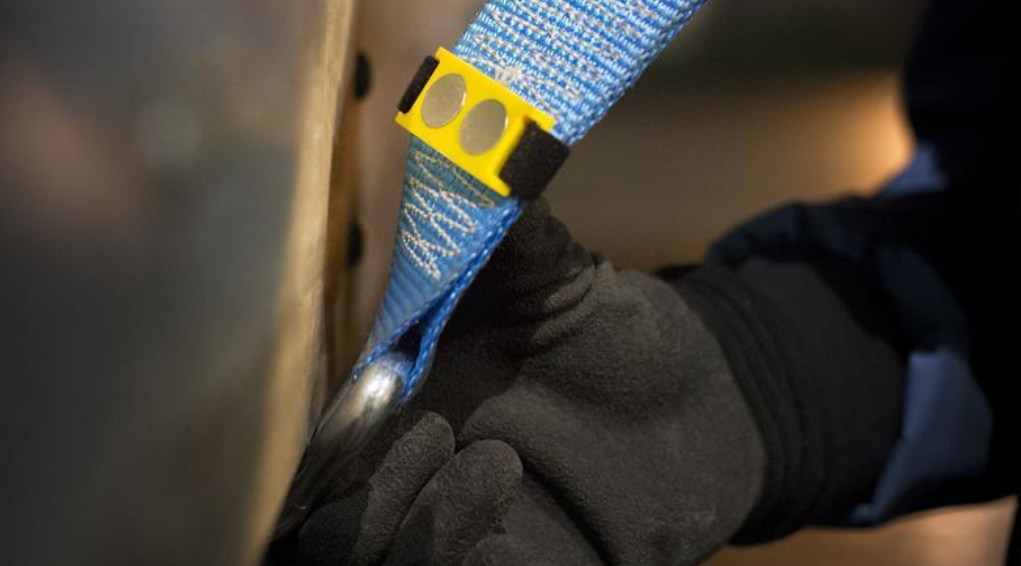Ratchet straps (also known as tie-down straps) are fasteners used to hold down equipment or cargo during transport. The straps are made from hardwearing webbing outfitted with tie down hardware and a ratchet for tensioning the strap. These straps are often used for fastening down goods on trucks, trailers, pallets, containers and boxes.
In this guide, we’re going to look at some of the commonly asked questions about ratchet straps and how to use them.
How To Thread A Ratchet Strap
In order to thread a ratchet buckle, place the webbing through the slot in the centre rotating spool of closed ratchet. Pull the webbing through, ensuring that you leave some slack and begin raising and lowering the handle. The webbing will wind itself and lock in place to that and further ‘ratcheting’ will increase the tension in the strap.
How To Release A Ratchet Strap
To release the strap, simply pull and hold the release tab on the top of the ratchet and open until both sides are in line. Pull the webbing from the side that isn’t fixed down in order to release the strap.
How To Store Ratchet Straps
It’s important to properly store ratchet straps so that they don’t become damaged by mould, UV rays, tears or friction. Before you do store your straps, check them thoroughly for any damage or tears.
Roll the ratchet straps up carefully and separately, this avoids having to untangle straps when you get them out for their next use. Rubber bands or zip ties can be used to keep the roll in place.
Place the secured ratchet straps away from direct sunlight or moisture to avoid any damage during storage, many drivers opt to keep theirs in a duffle bag or plastic toolbox for safe keeping.
How Much Weight Can A Ratchet Strap Hold
Ratchet straps are marked with a tag that highlights the break strength and working load limit of the strap. The break strength is the weight in Kg at which any load-bearing part of the ratchet strap fails. The working load limit is the maximum load assigned to each ratchet strap by the manufacturer, this should not exceed one-third of the overall assembly breaking strength.
The Guidance on Load Securing has recently been updated by the DVSA (Driver & Vehicle Standards Agency, formally VOSA). This guide details useful information for hauliers and operators on how the DVSA and other regulators expect loads to be secured during transit.
How To Adjust Ratchet Straps
To tighten your ratchet strap, place the hooks into position and pull the loose end of the strap away from the ratchet. This will remove any slack before you raise and lower the ratchet handle to tighten it. When the strap is fully taut, close the handle to lock it in place.
To loosen the strap, pull the release handle and completely open the ratchet. Once the strap is loose you can pull the ratchet to loosen the strap.
How To Use Ratchet Straps On A Truck
Once the cargo is secured in or on the truck, place the ratchet strap over the cargo. Hook the ends over the side of the truck bed, in the lashing rings/anchor points or in grooves on the van wall.
Pull the ratchet back and forth to tighten the strap, once it feels taut - check the strap to ensure it feels secure. Lock the strap securely by flipping the ratchet back into the closed position.
How Do Endless Ratchet Straps Work
Endless ratchet straps are ideally used when you’re bundling items together on a pallet or moving dolly. Also known as endless loop ratchet straps, they are available in a wide range of widths, lengths and colours to suit your needs.
We advise using corner protectors if you’re strapping together loads that can be damaged as ratchet straps can be tensioned very tightly.
How To Use Endless Ratchet Straps
If securing a load to a pallet, feed the endless ratchet strap through the bottom. Ensure that the strap is going in the same direction as the fork truck tines to avoid any damage being caused by the tines themselves.
Take the loose end of the strap and guide over the top of the pallet. Feed the webbing through the take-up spool on the ratchet and pull the extra webbing through so that there is no slack in the strap.
If needed, place your corner protectors over the edges of your cargo. As well as protecting the load itself, these will also protect your endless ratchet strap from abrasive cargo that could cause damage.
Once the slack has been removed, start to ratchet to the desired tension.
How Often Should You Replace Ratchet Straps
You should inspect your ratchet straps before and after each use to ensure no damage has occurred during transit. Even if your straps are stored away, we recommend checking them every couple of weeks to make sure they haven’t been damaged or corroded.
Typically, ratchet straps should last anywhere from 2 to 4 years depending on the usage and how well they have been protected from causes of damage. Moisture, direct sunlight, mould and mildew can all impact the lifespan of your ratchet straps so it’s always best to check your regularly!
Why Do Ratchet Straps Come LooseRatchet straps commonly come loose if the webbing has stretched under the movement of your load. As ratchet straps are always under tension, any disruption during transit such as potholes or speed bumps can contribute to your ratchet strap coming loose. If you do hit a bump, it’s important to check your load to ensure it is fully secure before continuing. If not, you can run the risk of the load shifting under the slack or worse, the hooks coming loose and the strap coming off the vehicle.
How To Tie Down A Car With A Ratchet Strap
For modern or smaller vehicles, secure the tyres with tyre straps in order to keep the car steady. These straps are designed to protect the body of the car. If your vehicle is large or made before 1999, it is best to use axle straps instead.
Once the tyres are secured, wrap the main strap around the back of the left front tyre, feed it through the diverter strap and pull it tight. Take the exposed end of the main strap and place through the centre hole of a ratchet strap buckle, leave a little slack and crank the handle to fully connect the straps. The main strap should squeeze into the side of your tyres, if not, repeat the process until it does.
Secure each wheel on the car in this way.
If you have any questions about ratchet straps or want to know more about the products that we sell at Nationwide Trailer Parts, contact a member of the team today on 0800 14 22 480.
